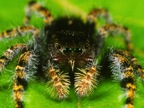
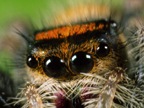

Jumping spiders, family Salticidae, are a very photogenic group of small spiders common throughout the world. Photogenic, that is, if one could get them to pose. That's the problem. Web-spinning spiders often willingly allow a photographer to approach, set up a tripod, and generally make a lot of disturbance before they become camera-shy. Jumping spiders are stalk-jump-kill hunters, without making a web, and they will readily try to escape when approached by a photographer.
I've found it most successful to capture specimens in the field, by sweeping or whatever means, and bring them back to the lab in a snap-top vial or petri dish for photographing. My camera set-up in the lab consists of the OM4T mounted on the Lepp II Dual Flash Macro Bracket with two T32 OM flashes, the 38/2.8 OM macro lens, and the 65-116mm telescopic auto extension tube. These are mounted on a focusing rail and finally on a sturdy tripod. The camera/flash combo is pointed at a small table tripod which has a roughly 6" square of plywood on it. One can clip, tape, or pin a leaf to this plywood piece for a background, or one can tape a petri dish with the captured jumper onto the platform. The tilt of both the platform and the camera can be changed to vary the angle of view on the spider.
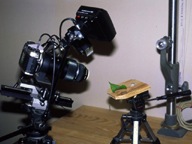
It's sometimes successful to simply transfer the jumping spider from its collecting vial onto the background leaf and hope for the best. The shots of both the Zygoballus (left) and the Marpissa (right) below were done this way.
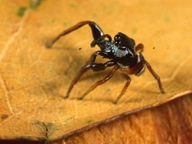
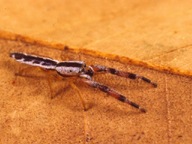
Zygoballus, adult male, 5mm long, to left; Marpissa pikei male, to right
If one adds a small prey to the vial or petri dish holding the captured jumper, however, and then has the jumper attack the prey before one releases the jumper onto the background leaf, one is more likely to get the jumper to stay on the background leaf once released. Like the junkyard guard dog at its food dish, jumpers can get pretty possessive of, and preoccupied with, their meal. The shot of the Hentzia below used this "feed 'em before you shoot 'em" technique.
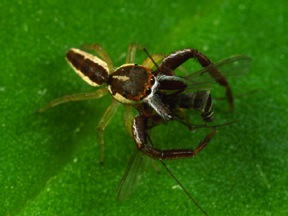
Similarly, if one finds a jumper in the wild holding a captured prey, one is often able to get close enough to photograph it. This is how the Phidippus below was photographed, after I found it on the side on an abandoned building. She was definitely, and perhaps proudly, glaring at me and saying "Don't you even think of taking this fly from me, buddy." A single flash to the upper left put too much of the spider's left legs, and the rear of the fly, in shadow, I feel.

One can also simply kill the jumping spider, arrange it on a background leaf, and then photograph it a bit more at ones convenience. I've found, however, that as I get older and, unavoidably, closer to the end of my own life, that I have a greater reluctance to end the life of anything as incredibly animate and alert as a jumping spider. Watching them, they seem every bit as cognizant of their own tiny world as I am of my much larger one. I increasingly practice "shoot and release" with them.
A non-emotional reason for not photographing a dead jumper is that the photographed jumping spider usually ends up looking, well, dead. Jumping spiders move their legs not by muscles but by hydraulics, and the fluid in the legs dries up all too quickly. This causes the legs to curl under the body, which makes it impossible to get the jumper into a realistic pose. The dead Synemosyna to the left looks OK; note the translucent legs. The dead immature Phidippus on the right, however, has started to dry out, and the legs are curling under the body. It's a poor shot.
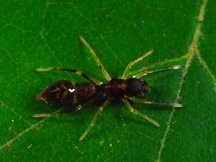
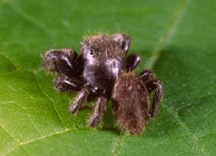
All for now. "Photographing Jumping Spiders: II" will cover cross-polarization of the two flash units. This is very useful with shooting jumping spiders. Larger views of most of the above photos are visible in Jumping Spider Album I.